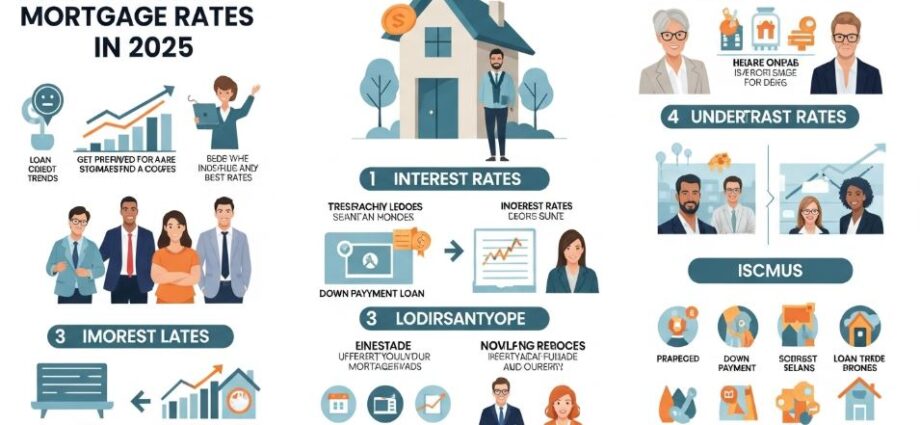Buying a home is one of the most significant financial decisions you’ll ever make. For most people, securing a mortgage is an essential step in this process. But with countless lenders and fluctuating interest rates, finding the best mortgage rates can feel overwhelming. This guide will provide you with practical tips and insights to navigate the mortgage market and secure a deal that works for you.
Understanding Mortgage Rates
A mortgage rate is the interest charged on your home loan. It’s expressed as a percentage and directly affects your monthly payments and the total cost of the loan over its lifespan. Mortgage rates are influenced by various factors, including:
- Economic Indicators: Inflation, the Federal Reserve’s policies, and overall economic conditions.
- Loan Type: Fixed-rate vs. adjustable-rate mortgages.
- Loan Term: Shorter terms (15 years) usually have lower rates compared to longer terms (30 years).
- Borrower’s Profile: Credit score, income, debt-to-income ratio, and down payment amount.
Strategies to Secure the Best Mortgage Rates
1. Improve Your Credit Score
Your credit score plays a critical role in determining your mortgage rate. A higher score signals to lenders that you’re a reliable borrower. Here’s how to boost your credit:
- Pay off existing debts and reduce your credit card utilization.
- Avoid opening new credit accounts before applying for a mortgage.
- Review your credit report for errors and dispute inaccuracies.
2. Shop Around and Compare Offers
Different lenders offer different rates, so it’s essential to shop around. Get quotes from at least three to five lenders, including banks, credit unions, and online mortgage companies. Use comparison tools to analyze loan terms, closing costs, and interest rates.
3. Choose the Right Loan Type
Understanding the types of mortgage loans can help you choose the best option for your needs:
- Fixed-Rate Mortgages: Offer stability with consistent monthly payments.
- Adjustable-Rate Mortgages (ARMs): Start with lower rates but may increase over time.
- Government-Backed Loans: FHA, VA, and USDA loans often come with lower rates but have specific eligibility requirements.
4. Make a Larger Down Payment
The more money you can put down upfront, the less risk you pose to lenders. A larger down payment can:
- Reduce your interest rate.
- Eliminate the need for private mortgage insurance (PMI).
- Lower your loan-to-value (LTV) ratio.
5. Lock in Your Rate
Mortgage rates can fluctuate daily. Once you find a favorable rate, consider locking it in to protect yourself from potential increases. Rate locks typically last between 30 and 60 days, though longer periods may be available.
6. Consider Discount Points
Discount points allow you to pay an upfront fee to lower your interest rate. Each point costs 1% of your loan amount and typically reduces your rate by 0.25%. This can be a good option if you plan to stay in your home for a long time and want to save on interest.
Current Trends in Mortgage Rates
As of 2025, the mortgage market continues to be influenced by various economic factors. Key trends include:
- Rising Rates: The Federal Reserve’s monetary policies have led to gradual increases in mortgage rates.
- Demand for Fixed-Rate Loans: Many borrowers prefer the stability of fixed-rate mortgages amid economic uncertainties.
- Technology-Driven Lending: Online platforms and tools have made it easier to compare rates and apply for loans.
How to Use Online Tools for Rate Comparison
The internet is a valuable resource for finding competitive mortgage rates. Here’s how to make the most of online tools:
- Mortgage Calculators: Estimate monthly payments based on loan amount, term, and interest rate.
- Rate Comparison Websites: Sites like Bankrate, LendingTree, and Zillow allow you to compare rates from multiple lenders.
- Prequalification Tools: Many lenders offer online prequalification, giving you a clearer picture of the rates you may qualify for.
Mistakes to Avoid When Shopping for Mortgage Rates
- Not Checking Your Credit Score: Many borrowers miss out on better rates by not improving their credit before applying.
- Ignoring Loan Fees: Focus not just on interest rates but also on closing costs and other fees.
- Failing to Lock Your Rate: Waiting too long to lock in a rate can result in higher costs if rates rise.
- Overlooking Smaller Lenders: Credit unions and local banks often offer competitive rates but are frequently overlooked.
Case Study: Securing the Best Rate
Let’s consider an example. Sarah, a first-time homebuyer with a credit score of 750, was looking for a $250,000 mortgage. By following these steps:
- Improving her credit score from 720 to 750.
- Comparing offers from five different lenders.
- Choosing a 15-year fixed-rate mortgage over a 30-year option.
Sarah secured a rate of 5.2% instead of 6%, saving her thousands of dollars over the loan’s lifespan.
Final Thoughts
Finding the best mortgage rates requires diligence, research, and strategic planning. By improving your credit, shopping around, and leveraging online tools, you can secure a favorable rate that aligns with your financial goals. Remember, even a small difference in interest rates can have a significant impact on your overall cost.
Take the time to explore your options, consult with financial advisors if necessary, and make informed decisions. Your dream home is within reach, and securing the right mortgage rate is a crucial step toward achieving it.

